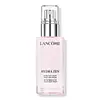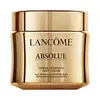What's inside
What's inside
 Key Ingredients
Key Ingredients

 Benefits
Benefits

 Concerns
Concerns

 Ingredients Side-by-side
Ingredients Side-by-side

Water
Skin ConditioningGlycerin
HumectantPentylene Glycol
Skin ConditioningOctyldodecanol
EmollientButylene Glycol
HumectantCaprylic/Capric Triglyceride
MaskingButyrospermum Parkii Butter
Skin ConditioningSimmondsia Chinensis Seed Oil
EmollientBeheneth-10
EmulsifyingSqualane
EmollientGlycol Palmitate
EmulsifyingPCA
HumectantAlanine
MaskingCocos Nucifera Oil
MaskingTocopherol
AntioxidantMacadamia Ternifolia Seed Oil
EmollientHydroxyacetophenone
AntioxidantSodium Polyacrylate
AbsorbentSodium Hyaluronate
HumectantSodium PCA
HumectantSodium Lactate
BufferingPaeonia Suffruticosa Root Extract
Skin ProtectingPhenylalanine
MaskingArginine
MaskingHelianthus Annuus Seed Oil
EmollientValine
MaskingPalmitoyl Tripeptide-8
Skin ConditioningXanthan Gum
EmulsifyingMenthol
MaskingAloe Barbadensis Leaf Juice Powder
Skin ConditioningPropylene Glycol
HumectantProline
Skin ConditioningIsoleucine
Skin ConditioningAspartic Acid
MaskingCoriandrum Sativum Fruit Oil
MaskingSorbitol
HumectantSerine
MaskingThreonine
Passiflora Edulis Seed Oil
EmollientRosa Gallica Flower Extract
AstringentHistidine
HumectantCitric Acid
BufferingPrunus Armeniaca Kernel Oil
MaskingDextran
Glycine
BufferingParfum
MaskingWater, Glycerin, Pentylene Glycol, Octyldodecanol, Butylene Glycol, Caprylic/Capric Triglyceride, Butyrospermum Parkii Butter, Simmondsia Chinensis Seed Oil, Beheneth-10, Squalane, Glycol Palmitate, PCA, Alanine, Cocos Nucifera Oil, Tocopherol, Macadamia Ternifolia Seed Oil, Hydroxyacetophenone, Sodium Polyacrylate, Sodium Hyaluronate, Sodium PCA, Sodium Lactate, Paeonia Suffruticosa Root Extract, Phenylalanine, Arginine, Helianthus Annuus Seed Oil, Valine, Palmitoyl Tripeptide-8, Xanthan Gum, Menthol, Aloe Barbadensis Leaf Juice Powder, Propylene Glycol, Proline, Isoleucine, Aspartic Acid, Coriandrum Sativum Fruit Oil, Sorbitol, Serine, Threonine, Passiflora Edulis Seed Oil, Rosa Gallica Flower Extract, Histidine, Citric Acid, Prunus Armeniaca Kernel Oil, Dextran, Glycine, Parfum
Water
Skin ConditioningOctocrylene
UV AbsorberHydrogenated Polyisobutene
EmollientEthylhexyl Salicylate
UV AbsorberAlcohol Denat.
AntimicrobialDimethicone
EmollientGlycerin
HumectantButyl Methoxydibenzoylmethane
UV AbsorberBis-PEG-18 Methyl Ether Dimethyl Silane
EmollientOctyldodecanol
EmollientCetearyl Alcohol
EmollientPEG-20
HumectantPetrolatum
EmollientButyrospermum Parkii Butter
Skin ConditioningCetyl Alcohol
EmollientHydroxypropyl Tetrahydropyrantriol
Skin ConditioningPhenoxyethanol
PreservativePropylene Glycol
HumectantButylene Glycol
HumectantZea Mays Oil
EmulsifyingPrunus Armeniaca Kernel Oil
MaskingTocopheryl Acetate
AntioxidantPassiflora Edulis Seed Oil
EmollientOryza Sativa Bran Oil
EmollientCetearyl Glucoside
EmulsifyingCaprylyl Glycol
EmollientPolyacrylamide
PEG-100 Stearate
Glyceryl Stearate
EmollientXanthan Gum
EmulsifyingCapryloyl Salicylic Acid
ExfoliatingAcrylates/C10-30 Alkyl Acrylate Crosspolymer
Emulsion StabilisingC13-14 Isoparaffin
EmollientDisodium EDTA
Dimethiconol
EmollientPentylene Glycol
Skin ConditioningLaureth-7
EmulsifyingPentaerythrityl Tetra-Di-T-Butyl Hydroxyhydrocinnamate
AntioxidantJasminum Officinale Extract
MaskingSodium Hydroxide
BufferingOryza Sativa
Limonene
PerfumingAdenosine
Skin ConditioningHydrolyzed Soy Protein
HumectantHydrolyzed Linseed Extract
Skin ConditioningLinalool
PerfumingMalus Domestica Fruit Cell Culture Extract
Skin ConditioningCitronellol
PerfumingCoumarin
PerfumingCI 19140
Cosmetic Colorant2-Oleamido-1,3-Octadecanediol
Skin ConditioningCitral
PerfumingCI 14700
Cosmetic ColorantParfum
MaskingWater, Octocrylene, Hydrogenated Polyisobutene, Ethylhexyl Salicylate, Alcohol Denat., Dimethicone, Glycerin, Butyl Methoxydibenzoylmethane, Bis-PEG-18 Methyl Ether Dimethyl Silane, Octyldodecanol, Cetearyl Alcohol, PEG-20, Petrolatum, Butyrospermum Parkii Butter, Cetyl Alcohol, Hydroxypropyl Tetrahydropyrantriol, Phenoxyethanol, Propylene Glycol, Butylene Glycol, Zea Mays Oil, Prunus Armeniaca Kernel Oil, Tocopheryl Acetate, Passiflora Edulis Seed Oil, Oryza Sativa Bran Oil, Cetearyl Glucoside, Caprylyl Glycol, Polyacrylamide, PEG-100 Stearate, Glyceryl Stearate, Xanthan Gum, Capryloyl Salicylic Acid, Acrylates/C10-30 Alkyl Acrylate Crosspolymer, C13-14 Isoparaffin, Disodium EDTA, Dimethiconol, Pentylene Glycol, Laureth-7, Pentaerythrityl Tetra-Di-T-Butyl Hydroxyhydrocinnamate, Jasminum Officinale Extract, Sodium Hydroxide, Oryza Sativa, Limonene, Adenosine, Hydrolyzed Soy Protein, Hydrolyzed Linseed Extract, Linalool, Malus Domestica Fruit Cell Culture Extract, Citronellol, Coumarin, CI 19140, 2-Oleamido-1,3-Octadecanediol, Citral, CI 14700, Parfum
 Reviews
Reviews

Ingredients Explained
These ingredients are found in both products.
Ingredients higher up in an ingredient list are typically present in a larger amount.
Butylene Glycol (or BG) is used within cosmetic products for a few different reasons:
Overall, Butylene Glycol is a safe and well-rounded ingredient that works well with other ingredients.
Though this ingredient works well with most skin types, some people with sensitive skin may experience a reaction such as allergic rashes, closed comedones, or itchiness.
Learn more about Butylene GlycolThis ingredient is also known as shea butter. It is an effective skin hydrator and emollient.
Emollients help soothe and soften your skin. It does this by creating a protective film on your skin. This barrier helps trap moisture and keeps your skin hydrated. Emollients may be effective at treating dry or itchy skin.
Shea butter is rich in antioxidants. Antioxidants help fight free-radicals, or molecules that may harm the body. It is also full of fatty acids including stearic acid and linoleic acid. These acids help replenish the skin and keep skin moisturized.
While Shea Butter has an SPF rating of about 3-4, it is not a sunscreen replacement.
Shea butter may not be fungal acne safe. We recommend speaking with a professional if you have any concerns.
Learn more about Butyrospermum Parkii ButterGlycerin is already naturally found in your skin. It helps moisturize and protect your skin.
A study from 2016 found glycerin to be more effective as a humectant than AHAs and hyaluronic acid.
As a humectant, it helps the skin stay hydrated by pulling moisture to your skin. The low molecular weight of glycerin allows it to pull moisture into the deeper layers of your skin.
Hydrated skin improves your skin barrier; Your skin barrier helps protect against irritants and bacteria.
Glycerin has also been found to have antimicrobial and antiviral properties. Due to these properties, glycerin is often used in wound and burn treatments.
In cosmetics, glycerin is usually derived from plants such as soybean or palm. However, it can also be sourced from animals, such as tallow or animal fat.
This ingredient is organic, colorless, odorless, and non-toxic.
Glycerin is the name for this ingredient in American English. British English uses Glycerol/Glycerine.
Learn more about GlycerinOctyldodecanol is a fatty alcohol. It is primarily used to enhance the texture of products.
As an emulsifier, Octyldodecanol helps prevent the oils and waters from separating. It also prevents ingredients from creating foam when shaken.
Octyldodecanol is created by reducing fatty acid to an alcohol.
Due to its high molecular weight, it does not get absorbed into the skin.
Learn more about OctyldodecanolParfum is a catch-all term for an ingredient or more that is used to give a scent to products.
Also called "fragrance", this ingredient can be a blend of hundreds of chemicals or plant oils. This means every product with "fragrance" or "parfum" in the ingredients list is a different mixture.
For instance, Habanolide is a proprietary trade name for a specific aroma chemical. When used as a fragrance ingredient in cosmetics, most aroma chemicals fall under the broad labeling category of “FRAGRANCE” or “PARFUM” according to EU and US regulations.
The term 'parfum' or 'fragrance' is not regulated in many countries. In many cases, it is up to the brand to define this term.
For instance, many brands choose to label themselves as "fragrance-free" because they are not using synthetic fragrances. However, their products may still contain ingredients such as essential oils that are considered a fragrance by INCI standards.
One example is Calendula flower extract. Calendula is an essential oil that still imparts a scent or 'fragrance'.
Depending on the blend, the ingredients in the mixture can cause allergies and sensitivities on the skin. Some ingredients that are known EU allergens include linalool and citronellol.
Parfum can also be used to mask or cover an unpleasant scent.
The bottom line is: not all fragrances/parfum/ingredients are created equally. If you are worried about fragrances, we recommend taking a closer look at an ingredient. And of course, we always recommend speaking with a professional.
Learn more about ParfumPassiflora Edulis Seed Oil is an oil and isn't fungal acne safe.
Pentylene glycol is typically used within a product to thicken it. It also adds a smooth, soft, and moisturizing feel to the product. It is naturally found in plants such as sugar beets.
The hydrophilic trait of Pentylene Glycol makes it a humectant. As a humectant, Pentylene Glycol helps draw moisture from the air to your skin. This can help keep your skin hydrated.
This property also makes Pentylene Glycol a great texture enhancer. It can also help thicken or stabilize a product.
Pentylene Glycol also acts as a mild preservative and helps to keep a product microbe-free.
Some people may experience mild eye and skin irritation from Pentylene Glycol. We always recommend speaking with a professional about using this ingredient in your routine.
Pentylene Glycol has a low molecular weight and is part of the 1,2-glycol family.
Learn more about Pentylene GlycolPropylene Glycol is an odorless, colorless liquid. As a humectant, it helps skin retain moisture. It also aids in delivering active ingredients.
Another role of this ingredient is preventing a product from melting or freezing. Propylene glycol also adds antimicrobrial properties to a product, elongating product lifespan.
This ingredient is considered an organic alcohol and commonly added into both cosmetics and foods.
Those with sensitive skin or conditions may develop a rash when using this ingredient.
Learn more about Propylene GlycolThis ingredient is the oil from the apricot.
Apricot Kernel Oil is an emollient and helps soften skin. This is due to its fatty acid components. Some of these fatty acids include linoleic and oleic acid.
This ingredient also has antioxidant properties from Vitamins A, C, and E. Antioxidants help fight free-radicals. Free-radicals are molecules that may damage your skin cells. Besides being antioxidants, these vitamins provide plenty of skin benefits as well.
Learn more about Prunus Armeniaca Kernel OilWater. It's the most common cosmetic ingredient of all. You'll usually see it at the top of ingredient lists, meaning that it makes up the largest part of the product.
So why is it so popular? Water most often acts as a solvent - this means that it helps dissolve other ingredients into the formulation.
You'll also recognize water as that liquid we all need to stay alive. If you see this, drink a glass of water. Stay hydrated!
Learn more about WaterXanthan gum is used as a stabilizer and thickener within cosmetic products. It helps give products a sticky, thick feeling - preventing them from being too runny.
On the technical side of things, xanthan gum is a polysaccharide - a combination consisting of multiple sugar molecules bonded together.
Xanthan gum is a pretty common and great ingredient. It is a natural, non-toxic, non-irritating ingredient that is also commonly used in food products.
Learn more about Xanthan Gum